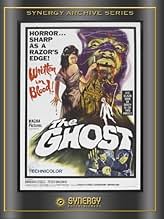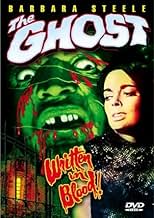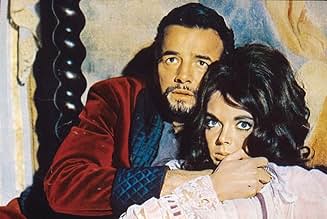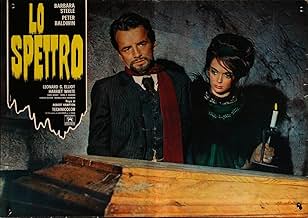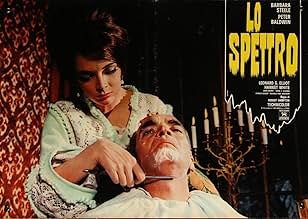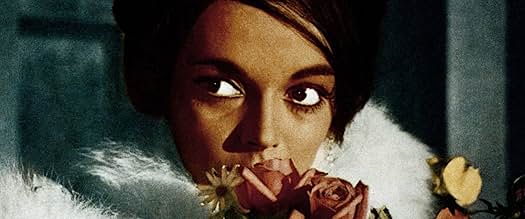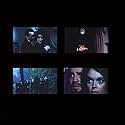IMDb RATING
6.1/10
1.6K
YOUR RATING
A woman and her lover murder her doctor husband, but when strange things start happening, they wonder if they really killed him, or if he has come back from the dead to haunt them.A woman and her lover murder her doctor husband, but when strange things start happening, they wonder if they really killed him, or if he has come back from the dead to haunt them.A woman and her lover murder her doctor husband, but when strange things start happening, they wonder if they really killed him, or if he has come back from the dead to haunt them.
- Awards
- 1 nomination total
Elio Jotta
- Dr. John Hichcock
- (as Leonard G. Elliot)
Harriet Medin
- Catherine Wood - Housekeeper
- (as Harriet White)
Carlo Kechler
- Police Superintendent
- (as Charles Kechler)
Umberto Raho
- Canon Owens
- (as Raoul H. Newman)
Featured reviews
Official/unofficial sequel to "The Horrible Dr. Hichcock" with the captivating Barbara Steele now playing the doctor's wife Margaret instead of Cynthia and Elio Jotta taking in the role of Dr. Hichcock himself. Titled simply "The Ghost" on my DVD collection the Dr. is now confined to a wheelchair and is administered small doses of a poison in order to dilute whatever is ailing him. Assisting him in his matters of health is the handsome Dr. Charles Livingstone who also is having an affair with Margaret. Late one night after a séance Margaret confides in Charles that she cannot take being around him anymore and that maybe he can administer a deadly dose of the poison to her husband in order for her to claim his inheritance and live together in the Gothic Scottish castle as the lovers they were meant to be. When Dr. Livingstone agrees and murders Dr. Hichcock the castle becomes haunted by the corpse with ghastly reminders of the dastardly deed. Complicating things even more is Dr. Hichcock's faithful housekeeper Catherine who seems to keep an attentive eye on Margaret and Charles' suspicious actions. When the Hichcock fortune turns up missing Margaret begins to wonder if her husband's ghost has hidden it or perhaps her beau hasn't been as truthful as she thinks he is. Dr. Livingstone I presume? Maybe.
Not much that hasn't been done before here though it is a pretty decent effort with a rather graphic scene for a movie made in the early sixties. Without a doubt this movie was augmented greatly by the performance of the large-eyed "Queen of Gothic Horror" Barbara Steele. Her portrayal of a wife with so much disgust for her crippled husband which is trumped only by her greed is powerfully done. The climax actually proves that Margaret and Dr. Hichcock were cut from the same cloth concerning the lack of morality and how they treat others to gain what they think should be theirs. Can become a little plodding during the 95 minute running time though the ending will keep you glued to the screen. The print of "The Ghost" unfortunately was taken from a degraded copy as some of the scenes jump from frame to frame which gets rather annoying from time to time. The dubbing at times are suspect as well. Funny how the setting was supposed to be in Scotland yet only one person spoke with a Scottish brogue and rather poorly at that. Not the greatest work I've seen from the Gothic horror genre though I believe fans of Barbara Steele would enjoy this.
Not much that hasn't been done before here though it is a pretty decent effort with a rather graphic scene for a movie made in the early sixties. Without a doubt this movie was augmented greatly by the performance of the large-eyed "Queen of Gothic Horror" Barbara Steele. Her portrayal of a wife with so much disgust for her crippled husband which is trumped only by her greed is powerfully done. The climax actually proves that Margaret and Dr. Hichcock were cut from the same cloth concerning the lack of morality and how they treat others to gain what they think should be theirs. Can become a little plodding during the 95 minute running time though the ending will keep you glued to the screen. The print of "The Ghost" unfortunately was taken from a degraded copy as some of the scenes jump from frame to frame which gets rather annoying from time to time. The dubbing at times are suspect as well. Funny how the setting was supposed to be in Scotland yet only one person spoke with a Scottish brogue and rather poorly at that. Not the greatest work I've seen from the Gothic horror genre though I believe fans of Barbara Steele would enjoy this.
As you might expect, this film is really quite similar to Riccardo Freda's earlier horror flick "The Terror of Dr Hitchcock", although for my money; I'd say this one is slightly better. The two films share a director and a lead actress in common, as well as a lead character name. This film firmly fits into the 'Gothic' side of Italian cinema, which Steele often starred in, and Freda makes excellent use of this style with some real standout cinematography. It became clear that Riccardo Freda was, in fact, a hack; as it turned out that the great Mario Bava did most of the work on a lot of his films, and his later stuff - Tragic Ceremony and The Iguana with the Tongue of Fire to name a couple - was a million miles away from being brilliant. This film would appear to be Freda at his best, therefore, and it's actually not bad. The plot centres on Dr. John Hitchcock; a cripple who wants to die. His wife is, naturally, having an affair with her husband's doctor, and pretty soon the two of them conspire to murder Dr Hitchcock for his money. However, they didn't bargain for him haunting them after his death...
The film's title suggests that it's a ghost story, but I would say that The Ghost is more of a mystery chiller. There's not a great deal of real bona fide horror, and to be honest; I felt the film was a little too talky and would have proffered it to be a bit more visceral. The film's main draw is, obviously, Barbara Steele and the 'Queen of Horror' looks great throughout the film. The decor and set design is great too, and these allow Freda to build an oppressive and macabre atmosphere, which benefits the plot line quite well. The main problem with the film is the fact that a lot of it feels really amateurish. The dubbing is atrocious (even more so than usual) and some of the things the characters say are ridiculous. Whether or not that's down to the translation, I don't know. The climax is the best part of the film for me. Of course, it's not a completely sense-making ending and there are a few holes left; but it's a nice twist at least, and it does justify the shortfalls of some of the rest of the movie. Overall, I won't go as far as to say that The Ghost is a horror classic; but it's good entertainment, and fans of Gothic horror will enjoy it.
The film's title suggests that it's a ghost story, but I would say that The Ghost is more of a mystery chiller. There's not a great deal of real bona fide horror, and to be honest; I felt the film was a little too talky and would have proffered it to be a bit more visceral. The film's main draw is, obviously, Barbara Steele and the 'Queen of Horror' looks great throughout the film. The decor and set design is great too, and these allow Freda to build an oppressive and macabre atmosphere, which benefits the plot line quite well. The main problem with the film is the fact that a lot of it feels really amateurish. The dubbing is atrocious (even more so than usual) and some of the things the characters say are ridiculous. Whether or not that's down to the translation, I don't know. The climax is the best part of the film for me. Of course, it's not a completely sense-making ending and there are a few holes left; but it's a nice twist at least, and it does justify the shortfalls of some of the rest of the movie. Overall, I won't go as far as to say that The Ghost is a horror classic; but it's good entertainment, and fans of Gothic horror will enjoy it.
This highly-regarded example of the Italian Gothic Horror style had eluded me until now; even so, having caught up with it at long last, I still wasn't done with the 'Curse Of THE GHOST': the Retromedia DVD proved faulty, with a glitch around the one-hour mark (where the image skipped and the audio dropped out) and then experienced complete freezing after 88 minutes - so much so that I had to finish the film off on another player! This was after a public domain copy I rented from Hollywood when I was there in late 2005 (which, on a hunch, I decided to check before watching) reverted to the Main Menu midway through the climax!!
Anyway, the film itself is undeniably a highlight of the genre and one of Freda's best (which he made in just 12 days): a follow-up, not a sequel, to his previous collaboration with star Barbara Steele - THE HORRIBLE DR. HICHCOCK (1962) - despite the re-use of that notorious character's surname. In the earlier film, too, Steele had been overshadowed by a delightfully manic turn from Robert Flemyng but, here, she lives up to her iconic status as the Queen Of Gothic Horror: few actresses have managed to replicate her sensual mix of wickedness and vulnerability; as for the actor playing Hichcock this time around, who looks a bit like Howard Vernon, he's not too bad - if no match, ultimately, for Flemyng.
Like I said with respect to Hammer's FEAR IN THE NIGHT (1972), the plot twists aren't very original - but they make for a great ride regardless; besides, one could just soak in the colorful visuals (even if the print involved features a lot of wear and tear!). Incidentally, the film is rather gory for its time (witness the 'ghost' exhibiting its decaying flesh and the brutal razor murder, with its wonderful device of having blood dripping across the camera lens to simulate the victim's POV), but the lush score (actually a collection of compositions by Francesco De Masi, Franco Mannino and Roman Vlad - billed under one Americanized name, Franck Wallace!) and a reasonable quota of chills (the creepy scenes where the doctor speaks through his faithful and vaguely sinister housekeeper - played by the ubiquitous Harriet White Medin - who, conveniently, doubles as a medium and the various 'apparitions' - wheelchair stumbling down the stairs, dangling corpse) are certainly par for the course...as is, after all, the film's decidedly languid pace.
The deftly ironic climax is very effective - as a self-satisfied Hichcock expounds on his clever machinations while the immobilized Steele looks horridly on, fully knowing that she'll be blamed for the housekeeper's death and, worse still, that she killed her lover for no reason (i.e. he didn't betray her by stealing the jewels, as she had mistakenly assumed, and these were now once more in Hichcock's hands). The English dubbing isn't too bad considering; however, given the story's Scottish setting, it's odd that only one voice actor would deem it fit to attempt a pertinent accent (i.e. the solicitor who reads Dr. Hichcock's will) - which then causes it to seem unintentionally amusing alongside the less heavy inflections of his fellow dubbing artists!
While Freda is often accused of being indifferent to his films (which he often did purely so as to recoup his gambling losses!), he was undoubtedly a pioneer: not only making the first Italian horror effort, but his masterful use of color in the Dr. Hichcock pictures certainly pushed the genre into that corner - after a solitary stab at it by Giorgio Ferroni in MILL OF THE STONE WOMEN (1960) - as few gothics were shot in black-and-white thereafter (notably three films featuring Steele herself, namely CASTLE OF BLOOD [1964], THE LONG HAIR OF DEATH [1964] and NIGHTMARE CASTLE aka THE FACELESS MONSTER [1965]); certainly, Freda's protégé Mario Bava followed his example...and gradually took over the genre!
Anyway, the film itself is undeniably a highlight of the genre and one of Freda's best (which he made in just 12 days): a follow-up, not a sequel, to his previous collaboration with star Barbara Steele - THE HORRIBLE DR. HICHCOCK (1962) - despite the re-use of that notorious character's surname. In the earlier film, too, Steele had been overshadowed by a delightfully manic turn from Robert Flemyng but, here, she lives up to her iconic status as the Queen Of Gothic Horror: few actresses have managed to replicate her sensual mix of wickedness and vulnerability; as for the actor playing Hichcock this time around, who looks a bit like Howard Vernon, he's not too bad - if no match, ultimately, for Flemyng.
Like I said with respect to Hammer's FEAR IN THE NIGHT (1972), the plot twists aren't very original - but they make for a great ride regardless; besides, one could just soak in the colorful visuals (even if the print involved features a lot of wear and tear!). Incidentally, the film is rather gory for its time (witness the 'ghost' exhibiting its decaying flesh and the brutal razor murder, with its wonderful device of having blood dripping across the camera lens to simulate the victim's POV), but the lush score (actually a collection of compositions by Francesco De Masi, Franco Mannino and Roman Vlad - billed under one Americanized name, Franck Wallace!) and a reasonable quota of chills (the creepy scenes where the doctor speaks through his faithful and vaguely sinister housekeeper - played by the ubiquitous Harriet White Medin - who, conveniently, doubles as a medium and the various 'apparitions' - wheelchair stumbling down the stairs, dangling corpse) are certainly par for the course...as is, after all, the film's decidedly languid pace.
The deftly ironic climax is very effective - as a self-satisfied Hichcock expounds on his clever machinations while the immobilized Steele looks horridly on, fully knowing that she'll be blamed for the housekeeper's death and, worse still, that she killed her lover for no reason (i.e. he didn't betray her by stealing the jewels, as she had mistakenly assumed, and these were now once more in Hichcock's hands). The English dubbing isn't too bad considering; however, given the story's Scottish setting, it's odd that only one voice actor would deem it fit to attempt a pertinent accent (i.e. the solicitor who reads Dr. Hichcock's will) - which then causes it to seem unintentionally amusing alongside the less heavy inflections of his fellow dubbing artists!
While Freda is often accused of being indifferent to his films (which he often did purely so as to recoup his gambling losses!), he was undoubtedly a pioneer: not only making the first Italian horror effort, but his masterful use of color in the Dr. Hichcock pictures certainly pushed the genre into that corner - after a solitary stab at it by Giorgio Ferroni in MILL OF THE STONE WOMEN (1960) - as few gothics were shot in black-and-white thereafter (notably three films featuring Steele herself, namely CASTLE OF BLOOD [1964], THE LONG HAIR OF DEATH [1964] and NIGHTMARE CASTLE aka THE FACELESS MONSTER [1965]); certainly, Freda's protégé Mario Bava followed his example...and gradually took over the genre!
Barbara Steele is great as the conniving wife of Dr. Hitchcock in this, Freda's sequel to The Horrible Dr. Hitchcock. She conspires with Dr. Hitchcock's physician (who is also her lover) to do away with her old, sick and wealthy husband, which leads to the old revenge-from-beyond-the-grave storyline. While clichéd and (mostly) predictable, this film remains a must-see for fans of atmospheric horror and, in particular, Italian horror films of the 1960's. Riccardo Freda's excellent work combining lighting, sound and camera movement creates an eerie and foreboding atmosphere which overcomes the films weaknesses and gives healthy punctuation to the films shocks. This movie is well worth tracking down, and is certainly deserving of wider recognition than it has thus far received.
Set in Scotland in the early 1900's, this very welcome sort-of-sequel to THE HORRIBLE DR. HICHCOCK (1962) concerns the sickly, wheelchair-bound Dr. John Hichcock (Elio Jotta), whose death is hurried along by his beautiful younger wife Margaret (Barbara Steele) and her handsome doctor/lover (Peter Baldwin), in whose care Dr. H had unwisely entrusted. They poison him and then can't seem to find the fortune that should have been stashed in his safe. While they search the grounds, under the watchful eye of the loyal housekeeper (Harriet White Medin), hubby's ghost seemingly returns to settle the score, driving the two of them to paranoia, madness and murder.
The routine storyline is given a boost by solid direction, atmospheric photography and, especially, a good cast. Though the dubbing is a bit sketchy at times, this is a must for Barbara Steele fans. She's impressively evil in her role and gets a lot of screen time. The twist ending is great and is worth waiting for, as well.
Score: 6 out of 10
The routine storyline is given a boost by solid direction, atmospheric photography and, especially, a good cast. Though the dubbing is a bit sketchy at times, this is a must for Barbara Steele fans. She's impressively evil in her role and gets a lot of screen time. The twist ending is great and is worth waiting for, as well.
Score: 6 out of 10
Did you know
- TriviaMade during the pseudonym craze of the 1960s, the music score was credited to "Franck Wallace." Italian composers usually registered their pseudonyms with their performing right society, the SIAE, and the identities were listed by Bianco e Nero and the Monthly Film Bulletin who both reported that Wallace was Franco Mannino. However, some reference sources such as Donald C. Willis in 1972 suggested "Franck Wallace" was a joint pseudonym for Mannino and Roman Vlad (the two composers sometimes collaborated and Wallace is a very rough transliteration of Vlad). Even more confusingly, Beat Records released the soundtrack in 2008 and discovered that the surviving tapes in the Nazionalmusic vaults were attributed to Francesco De Masi. So the CD went out credited to De Masi only. De Masi did not work with either of the other two composers, instead being asked at the behest of the director to do a new score, not liking Mannino's effort; what portions thereof are contained in the film, are unknown, as the director seemingly changed his mind again, as Mannino is credited in the film for the score.
- GoofsWhen Dr. Livingston removes the bullet from the wall, there is a close-up of him holding an entire cartridge in his hands.
- Quotes
Dr. John Hichcock: [hands around Margaret's throat] Feel how strong my grip is? But I won't kill you.
- ConnectionsFeatured in 100 Years of Horror: Ghosts (1996)
2025 Venice Film Festival Guide
2025 Venice Film Festival Guide
See the full lineup for the 2025 Venice Film Festival, taking place Aug. 27 – Sept. 9, 2025.
- How long is The Ghost?Powered by Alexa
Details
- Runtime
- 1h 37m(97 min)
- Sound mix
- Aspect ratio
- 1.85 : 1
Contribute to this page
Suggest an edit or add missing content

